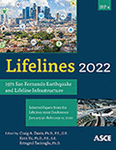Development of the Passive Damper System Realizing the Negative Stiffness Control
Publication: Lifelines 2022
ABSTRACT
The negative stiffness control is one of the structural control methods where the control force is negatively proportional to deformation. It has been clarified by past works that negative stiffness control makes it possible to decrease the existing stiffness of the structure to be installed, thereby suppressing the absolute acceleration and absolute displacement responses that are related to the damage of structure. When it comes to build an actual damper device, however, it can only be achieved by using sophisticated but complicated active controlled actuators or semi-active devices. This paper proposed a new vibration control device realizing negative stiffness in a passive manner was proposed. The prototype of the proposed device was assembled, and its performance was investigated through sinusoidal loading tests. It was found from the periodical loading tests that the proposed device generated the designated negative stiffness as well as friction energy dissipations in a good accuracy. It consequently follows that the proposed mechanism could successfully realize a negative stiffness control in a passive manner.
Get full access to this article
View all available purchase options and get full access to this chapter.
REFERENCES
Bruenau, M., Chang, S. E., Eguchi, R. T., Lee, G. C., O’Rourke, T. D., Reinhorn, A. M., Shinozuka, M., Tierney, K., Wallance, W. A., and von Winterfeldt, D. (2003). “A Framework to Quantitatively Assess and Enhance the Seismic Resilience of Communities.” Earthquake Spectra, Vol.19, No.4, pp.733-752.
Hollangel, E., Woods, D. D., and Leveson, N. (2006). Resilience Engineering – Concepts and Precepts,” CRC Press.
Iemura, H., and Pradono, M. H. (2002). “Passive and Semi-Active Seismic Response Control of a Cable-Stayed Bridge,” Earthquake Engineering and Structural Dynamics., Vol 9, 189-204.
Iemura, H., Kouchiyama, O., Toyooka, A., and Shimoda, I. (2008). “Development of the friction-based passive negative stiffness damper and its verification tests using shaking table,” Proc. of the 14th World Conference on Earthquake Engineering, No.14_12-01-0219.
Mokha, A., Constantinou, M. C., and Reinhorn, A. M. (1998). “Teflon bearings in aseismic base isolation: experimental studies and mathematical modeling,”, State University of New York at Buffalo.
Railway Bureau, Ministry of Land, Infrastructure, Transport and Tourism (supervised), and Railway Technical Research Institute (compiled). (2012). Design Standard for Railway Structures and Commentary (Seismic Design), Maruzen (in Japanese).
Sarlis, A., Pasala, D., Constantinou, M., Reinhorn, A., Nagarajaiah, S., and Taylor, D. (2013). “Negative Stiffness Device for Seismic Protection of Structures.” J. Struct. Eng., https://doi.org/10.1061/(ASCE)ST.1943-541X.0000616, 1124-1133.
Spencer, B. F., Jr., Dyke, S. J., Sain, M. K., and Carlson, J. D. (1997). “Phenomenological Model for Magnetorheological Dampers.” J. Eng. Mech., https://doi.org/10.1061/(ASCE)0733-9399123:3(230), 230-238.
Information & Authors
Information
Published In
History
Published online: Nov 16, 2022
Authors
Metrics & Citations
Metrics
Citations
Download citation
If you have the appropriate software installed, you can download article citation data to the citation manager of your choice. Simply select your manager software from the list below and click Download.
